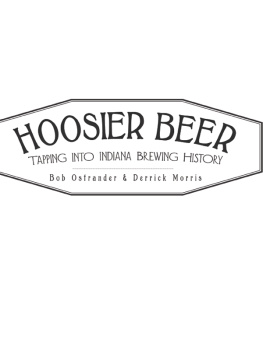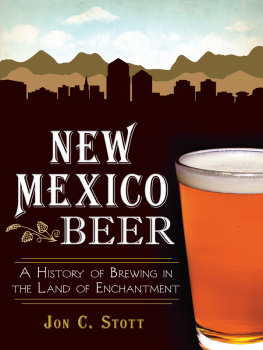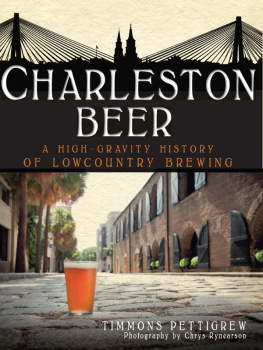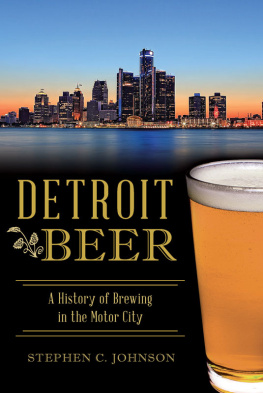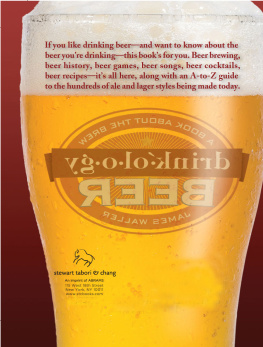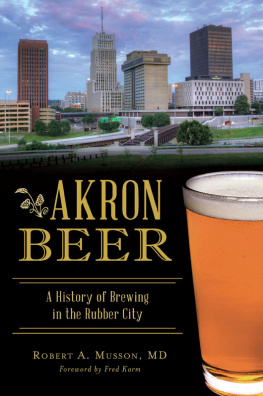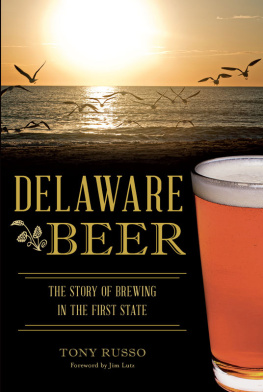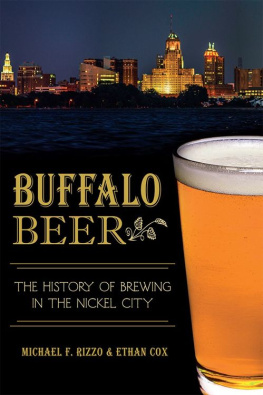

Published by The History Press
Charleston, SC 29403
www.historypress.net
Copyright 2011 by Bob Ostrander and Derrick Morris
All rights reserved
Images are from the Derrick Morris collection unless otherwise noted.
First published 2011
e-book edition 2012
ISBN 978.1.61423.426.5
Library of Congress Cataloging-in-Publication Data
Ostrander, Bob.
Hoosier beer : tapping into Indiana brewing / Bob Ostrander and Derrick Morris.
p. cm.
Includes bibliographical references and index.
print edition ISBN 978-1-60949-359-2
1. Breweries--Indiana--History. I. Morris, Derrick. II. Title.
TX950.57.I6O88 2011
663.4209772--dc23
2011023108
Notice: The information in this book is true and complete to the best of our knowledge. It is offered without guarantee on the part of the authors or The History Press. The authors and The History Press disclaim all liability in connection with the use of this book.
All rights reserved. No part of this book may be reproduced or transmitted in any form whatsoever without prior written permission from the publisher except in the case of brief quotations embodied in critical articles and reviews.
Beer, while being one of humanitys oldest beverages, can, when used to excess, be harmful to your body. Overuse can lead to weight gain, cirrhosis, alcoholism, halitotsis, DUI arrests and many other problems. This book does not advocate overindulgence.
Contents
Acknowledgements
We wish to thank lots of people for their work, advice, inspiration and support. Our wives, Terry and Karen, of course; collectors John Coughanowr and Steve Paddack; proofreaders Josh Dials, Taber Landwerlen, Mark Stober and Jeff Eaton; historian Ron Grimes of the MadisonJefferson County Public Library; Harold C. Feightner, executive director of the Indiana Brewers Association from 1934 until 1967, for keeping detailed notes of this period; the Indiana State Library for making Feightners notes available; John Holl for connecting us with The History Press; and Rita Kohn for believing.
We have set up a website, www.HoosierBeerStory.com, where you will find more information that wouldnt fit into these pagesmore pictures, newspaper clippings, period advertisements and anecdotes. Feedback from our readers is also invited; if you have family stories to add, please let us know.
We wrote this book mainly because we are fascinated by the industry. OK, maybe also because we like beer. We hope you bought this book to find out more about your mania. If not, maybe reading it will start you down that path.
About This Book
On these pages, youll find the complete history of the breweries of Indiana. About 370 commercial breweries have operated between 1816 and the present day. Well explore stories about all of them, including the following:
A farm brewery was part of the Underground Railroad during the Civil War and a speakeasy and bordello during Prohibition (Hoham/Klinghammer in Plymouth).
A large brewerys life was ended due to a labor strike (F.W. Cooks in Evansville).
One brewery was part of a utopian colony (New Harmony), and one was part of an Archabbey (Saint Meinrad).
One brewery recovered from $3,000 debt in 1881 (Joseph Miller in Covington). Another brewerys owner, when faced with a $5,000 debt in 1889, shot himself (Main Street Brewery in New Albany).
Several were in the back rooms of inns and hotelsearly examples of brewpubs.
One brewery bought the local newspaper in order to change its editorial stance during a temperance campaign (Indiana Brewing Association in Marion).
Some breweries were related to famous people, including Hew Ainslie, Tony Hulman, Richard Lieber, Cole Porter, Knute Rockne, Howard Hawks, Governor Robert Orr and Kurt Vonnegut.
A brewery and distillery company started a citys fire department (Great Crescent in Aurora).
Many breweries were taken over and managed by the widows of the owners, and some were started and operated by women.
One brewery paid its sales manager $108,000 per year during Prohibition (Kiley in Marion).
One brewery piped water from its spring to neighbors during the Civil Warand even built a bathhouse (Spring Brewery in Lafayette).
One came to an ignominous end when the president was arrested for income tax evasion after the ex-commissioner of the IRS got a $363,000 tax bill reduced to a $35,000 refund (Indianapolis Brewing Co.).
Many brewery buildings have gone on to other uses, including shopping malls, college classrooms, apartments and office buildings.
The first brewery in Fort Wayne, at the American Fur Trading Company post, was started by Francis Comparet and Alexis Coquillard, the founder of South Bend.
Brewery owners were jailed for selling bootleg beer during Prohibition. One was given probation because people would be put out of work (Huntington Brewery). One owner was jailed for bribing federal Prohibition agents (Southern Indiana Brewing Company in New Albany).
Breweries owned or sponsored minor-league and Negro League baseball teams. One sponsored the Notre Dame football team (Kamms in Mishawaka).
One brewery was built specifically to entice settlers in the 1850s to buy land in a new community (Cephas Hawks in Waterford).
One brewery closed three days before winning a gold medal at the Great American Beer Festival (Evansville Brewing Co.).
Many were started by immigrants to the United States from Belgium, England, France, Germany, Scotland and Switzerland.
One Brew on Premises was set up where anyone over twenty-one could brew his or her own beer.
Dozens of brewery owners served as mayors, bank presidents or congressmen.
A surprising number of breweries burned downsome multiple times. One man (Charles T. Doxey of Anderson) had a brewery, a barrel stave factory, an opera house, a handle factory, a music hall and a plate glass works destroyed by fire while he was a state senator, a U.S. representative and running for governor.
One brewery opened a famous restaurant in Chicago that is still operating (Berghoff in Fort Wayne).
One brewery was owned by a pipe organ builder (Louis van Dinter in Mishawaka).
Three modern-era breweries were opened by doctors.
Inventions from Indiana led to the modern CO2 regulator, beer line cleaning equipment and corn-adjunct beers.
The largest of the old-line breweries made over one million barrels (bbls) of beer annually (a barrel is thirty-one gallons; Sterling, Drewrys and Falstaff).
The largest of the modern-era breweries has a capacity of about fifteen thousand bbls (Three Floyds).

Map of Indiana showing the regions covered in this book.
Common Beer, Ale and Lager
COMMON BEER
Until 1857, all beers were fermented by wild yeasts. This, of course, included all beers made in Indiana. In southern Indiana, a specific style of beer made this way was called Common or Kentucky Common. The recipe used about 30 percent corn and 70 percent barley malt. Some roasted malt or artificial coloring was often added to the mix to darken it.
Fermentation of Common was done by a sour mash process. The brewery added (inoculated) a bit of beer from the last batch to introduce the yeast. This process is still used with sourdough bread, whiskey and some Belgian beers. The brewers term for this is krausening.
Next page
